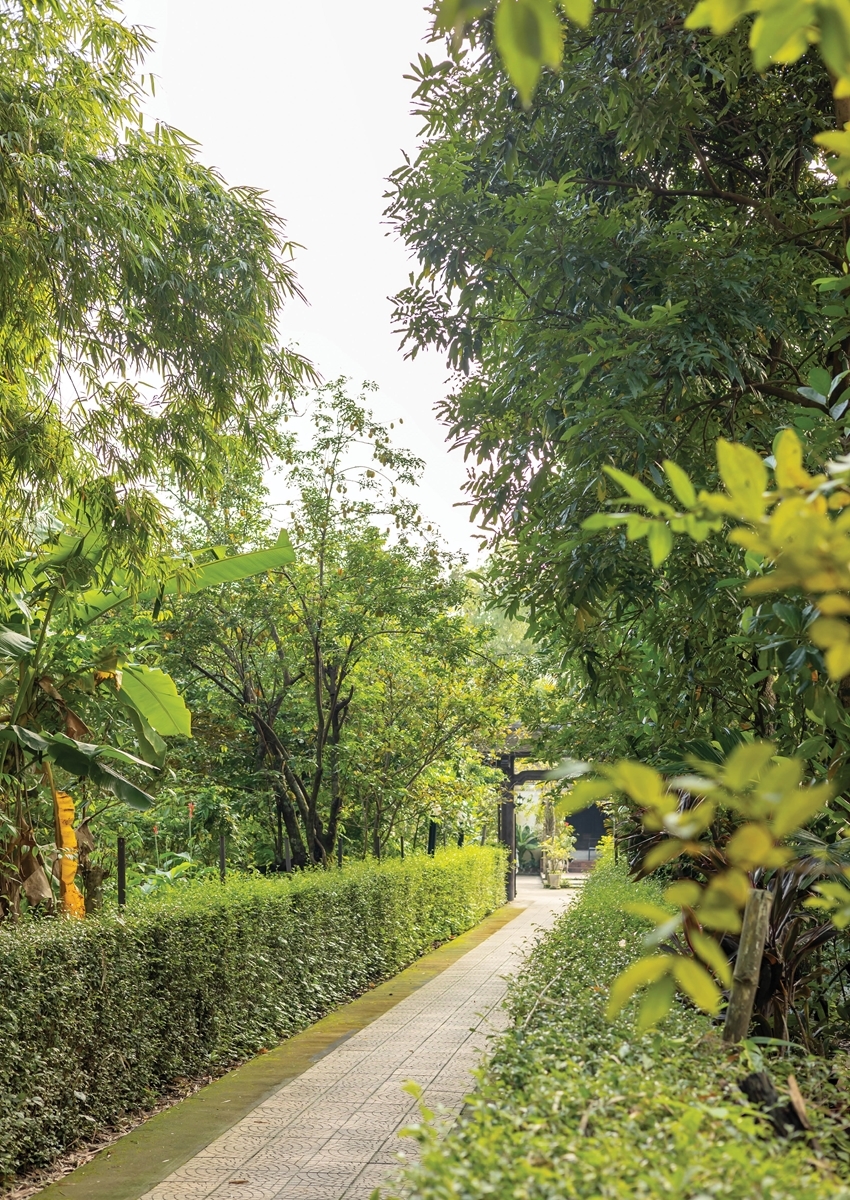 |
| A Hue-styled garden on Nguyen Binh Khiem Street. Photo: Trung Phan |
Spring in royal gardens
In the Imperial City of Hue, along with palaces are royal gardens. There, trees are valued for the four elements Co, Ky, Nha and Y. Co is age; the older, the more precious, Ky is shape; the stranger, the more valuable, Nha is style; the more noble-looking, the more cherished. Y is spirit, showing their flavor and fragrance. Trees in royal gardens are not trimmed meticulously in order to show that man lives in harmony with nature. That is the difference between ancient Vietnamese ornamental trees and those in some other countries. It is also the identity of Hue royal gardens.
Interestingly, in the royal gardens, the Nguyen Emperors also had many popular fruit trees grown such as mango, longan, jackfruit, banana, even millet, corn, etc., which showed their respect for agriculture. On Tet holidays, at the neu-tree-erecting ceremony, flowers in the royal gardens gave an elegant sweet smell.
During the time from Minh Mang’s era to Thieu Tri’s era, there were nearly 30 royal gardens in the Imperial City, creating the most gorgeous beauty. Of them Co Ha Garden was the most impressive with its unique style. Initially, Co Ha was where Prince Nguyen Phuc Dam (i.e., Emperor Minh Mang later) studied. Emperor Thieu Tri later upgraded it to become a famous garden.
At the end of the Nguyen Dynasty, the gardens fell into oblivion. In 2014, Co Ha Garden was embellished and currently owns nearly 600 rare ornamental plants collected from ornamental tree artisans from all over the country. In spring, orchids from everywhere gather here to “show off” their beauty and fragrance. It is like an orchid festival, which surprises many people.
Spring in countryside gardens
“Hue people build a garden, first of all, as a refuge for their soul on earth, wishing the garden would become spiritual heritage for their offspring…,” wrote Hoang Phu Ngoc Tuong. Hue gardens grow a variety of trees and plants. They lead their “democratic” prolific lives. That kind of folk garden look rustic, but surprisingly rich in human philosophy.
Ancient Hue was famous for its specialties such as Huong Can tangerines, Nguyet Bieu grapefruit, Citadel longans, Phung Tien lychees, Tuan green tea, etc. In spring, they all gave blossoms at the same time, filling the city with beauty and fragrance.
In the book O Chau Can Luc, Duong Van An wrote the lychee trees in Hue were of the same kind of the 100 lychee trees that Emperor Wu of Han brought from Giao Chi to plant in a garden in China. In spring, bunches of white lychee blossoms bloom and their gentle fragrance pervades everywhere.
Famous Huong Can tangerines used to be offered to the kings. Poet Tung Thien Vuong Mien Tham wrote about Huong Can tangerines, “Through rain, wind and dew/ wishing to be peeled by a lover/ to realize it is fragrant to the bones.” Only Huong Can tangerines are that aromatic. Recently, thanh tra grapefruit becomes a fruit symbol of Hue. In spring in vast thanh tra grapefruit gardens in Nguyet Bieu, clusters of white flowers swing in the wind. The white color combines with the golden sun to create the color of love and a poetic painting.
Spring hidden in Zen gardens
With the motto “using nature as the context for liberation of enlightenment,” gardens in pagodas, big or small, all look very natural. In the past, in spring, flowers bloomed in the shade of fruit trees such as jackfruit, coconut, mangosteen, longan, etc. Now Hue pagoda gardens are more ornamental with lawns, flower gardens, rockeries and pavilions on water.
The special thing is that fruit trees grown in pagoda gardens must be typical and meaningful. Flowers must be fragrant such as sweet osmanthus with a passionate aroma which tempts so many people. Almost every pagoda in Hue grows plumeria to remind people of the beauty of kindness. Fig trees at pagodas symbolize the eradication of 108 human afflictions. Jackfruit trees represents great wisdom. Some pagodas grow canon ball, representing purity. Because its Vietnamese name is Vo uu (meaning without sadness,) it is believed to help people be enlightened and avoid troubles.
Walking in pagoda gardens in spring, visitors can feel the fragrance of flowers. It is just like the fragrance of Zen.
Spring with ochna
But in spring in the South, ochna still dominates, and when it comes to ochna, one immediately thinks of Hue. Ochna gives green buds and five-petaled flowers in yellow. Hue is realizing its dream to become the “kingdom of ochna of Vietnam.” Ochna is grown at each gate as a reminder of preserving the Hue spirit as put poetically by Nguyen Xuan Hoang: “Flowers bloom in fog, in the new morning sun, in the cold wind, but still as yellow as silk…”
It is as if Cao Ba Quat’s footsteps during the time he worked in Hue as a mandarin were still here. In the spring, the poet joined his hands together and bowed to ochna. Ancient people worshiped ochna and drank wine dreaming about doing big things. Why ochna? As put by Nguyen Trai “Xuan den hoa nao chang tot tuoi/ Ua vi may tiet sach hon nguoi” (“In spring, every flower is fresh./ But you (ochna) are liked because your soul is cleaner than humans’.)
